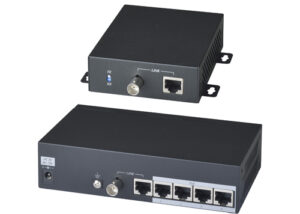 Utilising existing coaxial cable can provide users with a flexible, powerful migration path says AMG Sales and Technical Support Manager Ian Creary
Utilising existing coaxial cable can provide users with a flexible, powerful migration path says AMG Sales and Technical Support Manager Ian Creary
While it’s generally acknowledged that the rise of IP technology pushed the video surveillance industry forward, in features, responsiveness, storage, analytics and more, there are still companies who are reluctant to make the move from analogue to digital systems.
“That’s understandable,” says Ian Creary . “They are worried that the migration to IP simply won’t fit their budget. And it can be a sizeable investment, particularly if you have previously poured resources into a substantial analogue cabling infrastructure.”
But Ethernet over Coax technology is often overlooked as a cost-effective route from analogue to IP for many users.
“There is a very large legacy install base of coaxial cable in existence, mainly related to analogue CCTV, and making use of this as a part of any analogue to IP system migration plan could certainly prove to be a cost effective option,” says Ian. “Without the requirement to install new cabling, labour requirements reduce dramatically. This can mean an Ethernet over Coax install can cost as little as 25 percent of the expense of a full IP upgrade. The advantages of an Ethernet over Coax solution are in the simplicity of its design and application: installation is easy and the data and images it provides are reliable, so everyone involved saves money.”
EoC advantages
The original and currently standard Ethernet over Coax products are point-to-point. That is, there is one locally powered transceiver at the camera and locally powered receiver at the control room. While this is perfect for small systems, Ian Creary says it is not really efficient for larger systems which will feature many IP cameras.
“A better solution for these larger systems that still want to benefit from utilising their existing analogue infrastructure is use a PoE switch, with four PoE ports and one coax uplink port at the camera,” he says. “This gives the user more leverage of their existing cabling system, and truly allows an easy and cost-effective upgrade to IP cameras.”
Solving Ethernet distance issues
With Ethernet cabling, and devices that are Powered over Ethernet, additional networking products need to be installed every 100m. According to Ian Creary, for installers that typically means a requirement to source power in difficult to access locations throughout the facility, as these network products need to be located appropriately.
“This usually requires a lockable closet, cabinet or enclosure and units with power supplies inside,” he explains. “Ethernet over Coax devices, however, can be powered from a PoE switch, and deliver Power over Ethernet up to 300m. There are no repeaters or other networking products required, so the distance issue is addressed without an impact on the project budget.”
Keeping installation simple
Ease of installation is key to the appeal of Ethernet over Coax, Ian says. “Ethernet over Coax products provide an easy-to-connect, transparent network that is very simple to use, reliable, and offers seamless integration between the existing coaxial cable and the Ethernet backbone of the new system.
“The solution itself can be a simple design, and application is even more straightforward. Importantly, the data carried over the EoC network is robust and reliable, allowing for the transmission of high quality images and other sensitive security content. Ethernet over Coax technology will enable more installers to approach an IP migration project with a new set of financial and installation options. The end result is a high-performance system that saves all parties involved time, money, and concerns over flexibility and adaptability.”

